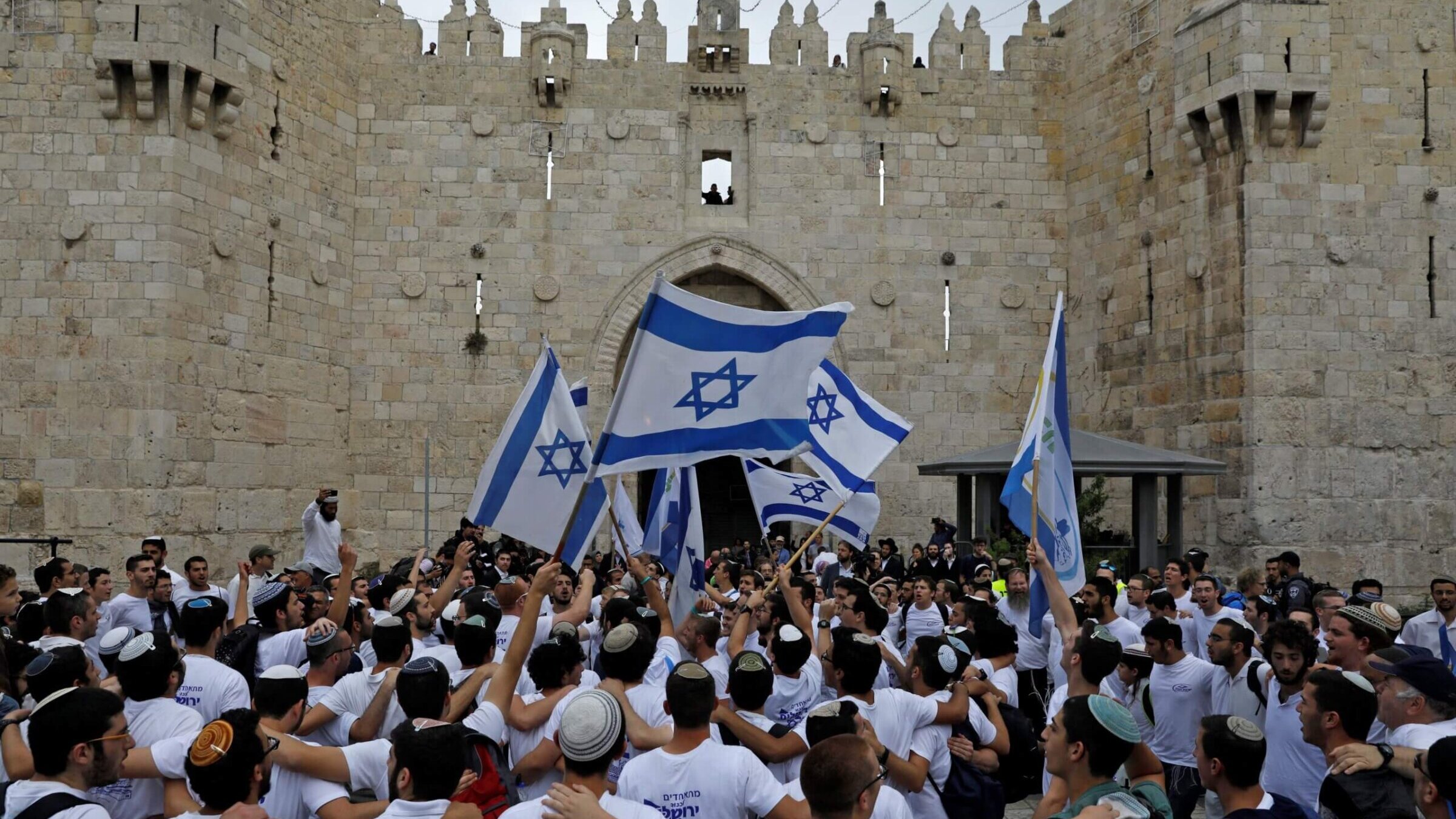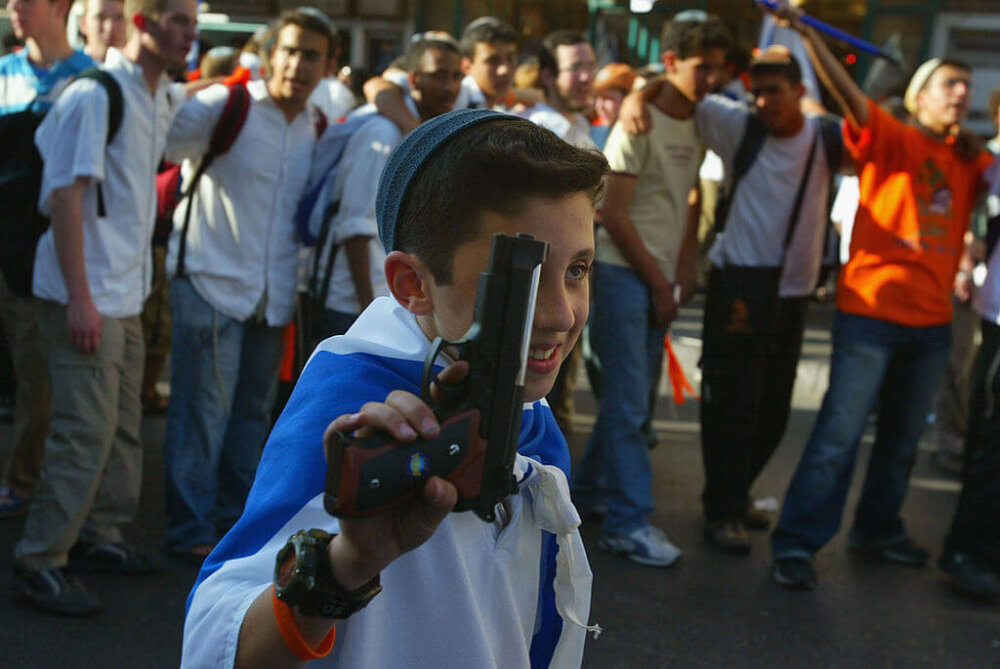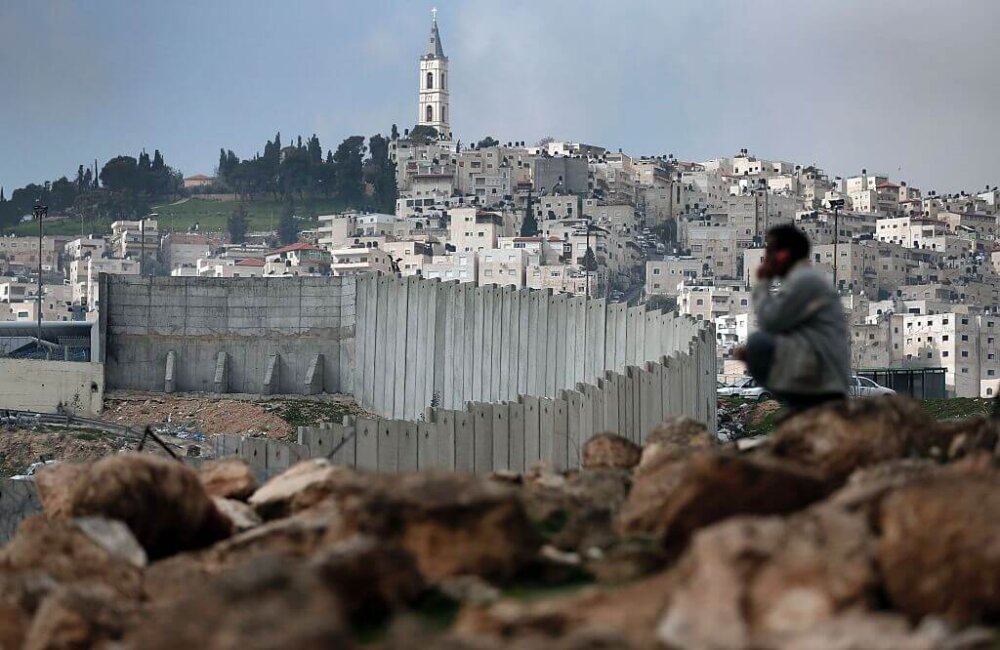On Jerusalem Day, what ‘united’ Jerusalem are people talking about?
The reality of Jerusalem is far more divided and inequitable than Jerusalem Day proponents would have you believe

Israeli nationalist settlers wave their national flag as they celebrate the Jerusalem Day at the Old City’s Damascus gate in Jerusalem on May 13, 2018. Photo by Menahem Kahana/AFP via Getty Images
For anyone experiencing the Flag March on Jerusalem Day, it’s hard to ever shake it from your head. An Israeli holiday created to commemorate the 1968 unification of East and West Jerusalem, Jerusalem Day’s Flag March is one of the most heinous public acts held in Israel.
Israeli Jews, including many settlers from the West Bank, are encouraged by their political leaders to scream and wreak mayhem in the narrow streets of the Old City’s Muslim quarter. March participants, many of whom are young kids and teens, disrupt Muslim prayer, verbally abuse Palestinian residents and attempt to claim sovereignty over this holiest of cities. This year, there were even t-shirts especially designed with the Star of David emblazoned with a rifle.
The Flag March is shepherded by extreme right-wing Jewish nationalists to lay claim to the entirety of Jerusalem and intimidate the Palestinians living in the Old City. This year’s march was led by Otzma Yehudi leader and Israel’s Minister of National Security Itamar Ben-Gvir with several of his government allies.
There is simply no way that this is a celebration of unity; rather, it is a celebration of control and domination.
That’s because the reality of Jerusalem is completely different from the “united city” fantasy told by politicians and Israel advocates. Anyone who honestly looks at the city will see two cities: East and West.
West Jerusalem is populated almost solely by Jews, increasingly by ultra-Orthodox and Haredi communities. East Jerusalem today stretches deep into the West Bank, encompassing Palestinian villages that almost no Israeli, let alone the average American tourist, would realize are technically part of the capital city. No Hebrew is spoken, and the residents have little engagement with or receive support from Israel day to day. For most, their heart and their culture are in the missing Palestinian state.
Each year before Jerusalem Day, the Jerusalem Institute for Policy Research releases updated statistics about the city. As of 2022, the population was 950,100 residents within the greater Jerusalem city borders, nearly 40% of whom are Palestinian.
If you are a Palestinian resident born in East Jerusalem, you are given Israeli residency but not an Israeli passport, which means you can only vote in municipal elections (most Palestinian residents don’t vote in the city elections either, since they consider themselves living under occupation). Palestinians in Jerusalem not only are marginalized politically, but also culturally. While there has been increasing progress in enhancing education in East Jerusalem with committed educators figuring out a middle ground regarding how courses are taught, and how to balance the extraordinary political and cultural sensitivities, these gains threaten to be undone by the current Israeli government.

Israel’s Education Minister, Yoav Kisch, is not known for his subtle touch when it comes to education policies. He has shown no nuance or sensitivity to the complicated situation in East Jerusalem schools compounded by cultural and political issues. While there has been progress made in upgrading standards in East Jerusalem, the reality is that politics and citizenship impact East Jerusalem education.
The inequity between the two halves of Jerusalem is also visible. Anyone traveling West to East can see the inequity in services — especially housing and public space. Jewish settlers continue to encroach on traditionally Palestinian neighborhoods like Silwan and Sheikh Jarrah. Roads, public parks and school buildings in East Jerusalem are all sub-standard compared to what exists in West Jerusalem. A new Palestinian neighborhood slated for East Jerusalem was just canceled by Jerusalem Mayor Moshe Leon, who said publicly that continuing with the development would hurt his re-election chances.

Meanwhile, about half the city’s Jewish population is Haredim, most of whom do not serve in the army, and are not in schools that teach proper language, mathematic or science skills necessary for participating in the workforce. Under the current Netanyahu government, even more financial resources are going to keep students from learning outside of their yeshivas and to keep them from the army. This will only enhance the sense that there is a huge swath of population living within but not of the city. Haredi neighborhoods function almost as closed enclaves, following their own rules regarding women’s public presentation and closing streets from traffic on Shabbat, and insisting on a segregated lifestyle.
Jerusalem is one of the poorest cities in Israel. About 40% of families in the city live below the poverty line, which is almost double the national average. This percentage is spread across the Palestinian and Haredi sectors, but Haredi residents have access to far more government support and social services. All signs point toward increased poverty, due to the politics of the so-called united Jerusalem.
Despite its poverty, Jerusalem is Israel’s capital, and there are potential sites of renewal and connection between Jewish Israeli and Palestinian residents. The nation’s leading university, Hebrew University, is increasingly educating more Palestinian students. The national arts college, Bezalel, just moved into a state-of-the-art sprawling campus in the center of town. Just a few blocks away from Bezalel is the brand-new Jerusalem Campus for the Arts, home to four of Israel’s leading arts schools. Both of these campuses received generous U.S. philanthropic support. Within these classrooms, there is indeed a different Jerusalem—creative, dynamic, and more equal between Jewish and Palestinian students and faculty. Now, it’s incumbent on American Jews who care about Jerusalem to ensure that students in these stellar schools can thrive—Jewish and Palestinian both.
To keep Jerusalem in poverty is not viable nor is a united city that simply dominates the residents of East Jerusalem. There is no democratic scenario here. Today, there are more than 360,000 Palestinians living in East Jerusalem without Israeli citizenship. Is Israel prepared to offer them citizenship for the sake of a united, functional city?
If we really want to celebrate Jerusalem in all its history and diversity, we need to look at it with clear eyes, unbridled by ideology and triumphalism. This precious and ancient city is suffering. Jerusalem deserves better from those who profess to love it.
To contact the author, email [email protected].
















